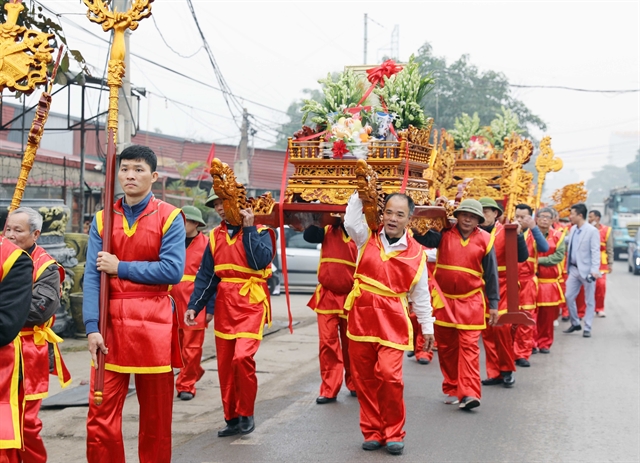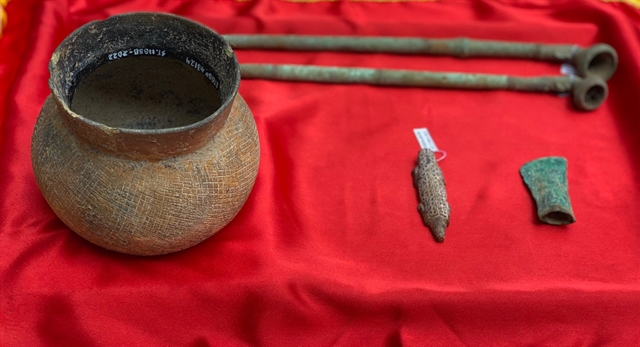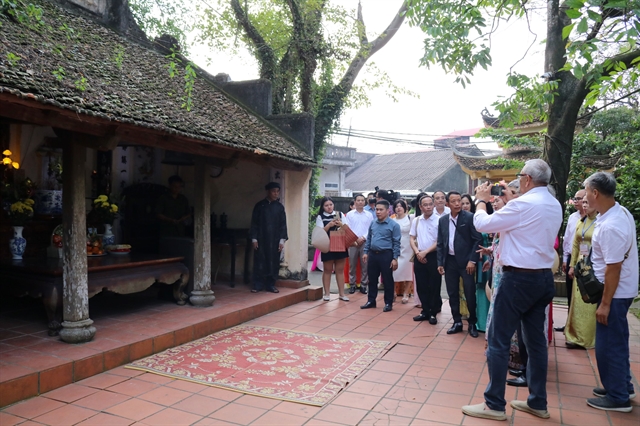 Life & Style
Life & Style

HÀ NỘI – Ten artefacts, the earliest dating back to the Đông Sơn civilisation (BC 1,000 – AD 1st century), were handed to the Việt Nam National Museum of History on Friday.
The artefacts include a stone axe of the Post Neolithic Era (BC 4,500-3,500), three bronze axes and one ceramic saucepan of Đông Sơn civilisation; three stone crocodile sculptures of AD 1st – 2nd century and two bronze pipes from the 17th-18th century.
The artefacts were rediscovered in the US nearly ten years ago. In 2013, the FBI found that Donald Miller, an amateur archaeologist in Indiana, illegally possessed many artefacts from around the world.
 |
| Pam DeVolder, Public Affairs Counselor (second from right) hands artefacts to Nguyễn Văn Đoàn, Director of the Việt Nam National Museum of History. VNS Photos Lê Hương |
In 2014, the FBI seized over 7,000 objects from him, who then rejected his right to the objects and cooperated with the FBI to return them to their legal owners.
In 2019, the FBI called on foreign governments to contact them and to send experts to examine the artefacts.
The Việt Nam embassy in the US informed the Ministry of Culture, Sports and Tourism that the FBI proposed handing back some artefacts confirmed to be of Vietnamese origin. In mid-2022, the ministry sent a letter to the embassy expressing the willingness to receive all the artefacts.
In August, the Việt Nam Embassy in the US received the artefacts from the FBI. Two months later, the artefacts were sent to Việt Nam and transferred to the museum, where experts examined them once more.
 |
| Some of the returned artefacts. |
Addressing the ceremony on Friday, Pam DeVolder, Public Affairs Counselor for the US Mission to Việt Nam, stressed that the US government is poised to support Việt Nam in the investigation, research, reclamation and return of illegally-traded antiquities to their rightful countries.
"This has been demonstrated through a Memorandum of Understanding on prevention and control of trans-national crimes, which was signed by the Việt Nam Ministry of Public Security and the FBI," she said.
She further said that besides supporting the effort of transnational crime prevention for culture and the arts, the US Government also supports other countries with a wide range of cultural programmes, such as funding opportunities for cultural preservation, with the most notable example being the Ambassador's Fund for Cultural Preservation.
"To date, the US government has provided more than US$1,246,775 in funding for the preservation of Vietnamese cultural artefacts, spanning 16 projects across the length and breadth of Việt Nam," she said.
 |
| The FBI administered the return of the artefacts. |
Nguyễn Văn Đoàn, director of the museum, appreciated the value of the returned artefacts.
"We are trying to complete a scientific dossier for the ten artefacts and do further research as well as plan to develop the value of these artefacts," he said.
Historic building
At the same event, the museum also officially opened a special exhibition titled "From the French School of Extreme Orient to the National Museum of Vietnamese History", featuring documents and images of the 90-year-old building, which was the first Louis Finot Museum of the French School of Extreme Orient in 1932 and then used as a part of the Việt Nam National Museum of History.
The exhibition is divided into three parts: history and the establishment of the building, important periods to transfer the building into the Việt Nam National Museum of History and the Việt Nam National Museum of History – a new stage.
The exhibition introduces the construction process of the building, its architecture, and its function at the beginning period under the French regime (1932-1957).
The building was built as an important museum in Indochina in the early 20th century. On January 20, 1900, the French School of Extreme Orient was established, which needed a museum to preserve and exhibit architectural objects.
In January 1926, construction began on a total area of 1,835sq.m in the same place as the French School's office behind the Opera House.
The completed Louis Finot Museum has a great hall in an octagon shape, which was modelled on popular Eastern wooden architecture. Various decoration patterns outside the building were also taken from the Eastern architectural style.
 |
| The audience at the exhibition on the main building of the museum, which was built 90 years ago by the French. |
The museum was transferred to the Vietnamese government in 1945 when it was used as the National Museum. In 1998, the museum was renovated when the outdoor garden was mobilised for exhibiting artefacts.
Throughout 90 years, the building has become a heritage site and has been used as the initial function.
The exhibition on the historical building will run till March 2023. VNS




